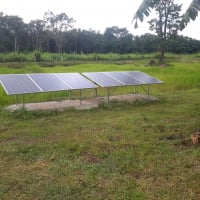Importance of Open Circuit voltage with reference to an Inverter.
Why exactly is open circuit voltage important for sizing a string ? Why should the max system voltage be calculated based on the open circuit voltage and not the operating voltage ?
If I connect a string whose system voltage according to Voc > Max Input voltage of inverter but system voltage according to max operating voltage < Max input voltage, what's gonna happen ?
Voc is ultimately "open circuit" voltage. There is no current flowing through the inverter if the circuits are open on the AC side. So why would it harm the inverter in anyway ?
How can voltage only harm an inverter if there is no power ... if there is no real current flowing ? And soon as there is loading, the voltages will drop down to the operating voltage which is well under the limits.
So why are strings sized according to Voc of a panel and not max operating voltage ?
I know this is a major misconception but I just can't understand it. I'd appreciate any help.
Comments
-
The printed circuits in a charge controller have copper tracks which the components are connected to, the space between them limits the voltages, wider gaps, higher voltage. So even if there is no current flow, the potential difference is still there, if the dielectric strength between is compromised, current will flow, in a not so useful way. Electronic components themselves have voltage limitations, so that needs be considered. Thats why the controller will have a maximum voltage limit to stay within safe operating parameters, which are probably quite conservative in quality equipment, perhaps not so, in cheap economic brands.1500W, 6× Schutten 250W Poly panels , Schneider MPPT 60 150 CC, Schneider SW 2524 inverter, 400Ah LFP 24V nominal battery with Battery Bodyguard BMS
Second system 1890W 3 × 300W No name brand poly, 3×330 Sunsolar Poly panels, Morningstar TS 60 PWM controller, no name 2000W inverter 400Ah LFP 24V nominal battery with Daly BMS, used for water pumping and day time air conditioning.
5Kw Yanmar clone single cylinder air cooled diesel generator for rare emergency charging and welding. -
The problem would most likely show up as the sun comes up on a cold morning. Panels have higher voltage when cold, and don't need direct sunlight to get the voltage up. The weak dawn light gets some current flowing. As Mcgivor said, the potential voltage is there even if current is minimal. The voltage will drop when the controller starts charging, but has to get that far without letting the magic smoke out first.
This is why strings are wired so Voc at the lowest expected low temperature in the location is comfortably under the charge controller limit. In most locations you can't just use the spec for Voc alone - it needs to be adjusted for local temps.Off-grid.
Main system ~4kw panels into 2xMNClassic150 370ah 48v bank 2xOutback 3548 inverter 120v + 240v autotransformer
Night system ~1kw panels into 1xMNClassic150 700ah 12v bank morningstar 300w inverter -
As said above, things like mosfets have a maximum voltage and a maximum current rating.
I am available for custom hardware/firmware development
-
As Jonr and others have said, the Voc (cold cells) is the maximum input voltage under no-load that the charge controllers (and Grid Tied Inverter, etc. that are connected to the solar array) will see.
Most devices that connect to solar panels have modes where they do not pull any current--Such as battery bank is full for a charge controller, a Grid Tied AC inverter when the AC mains have failed, an open fuse/circuit breaker, etc.
Mostly, it is the various "switches" (transistors, MOSFETs, other FETs, etc.) that connect to the Vpanel input that limited maximum input voltage.
And it does not have to be a lot of current--Just the over voltage (even an ESD--Electrostatic Dischage--A spark you get on a dry day walking across a carpet and such) is enough to "stress" electronic devices and cause them to have a shortened life.
Some charge controller vendors (such as Midnite Solar) can allow higher Voc from the solar array because the voltage the "power transistors" see is reduced by the battery bank voltage (i.e., maximum input voltage of 150 VDC for device + 48 volts of the battery bank = 198 VDC max Vpanel input before damage/exceeding specifications). Note that this "Hypervoltage" limit (in Midnite's case) is a non-operating limit (controller shuts down at 150 VDC input, will log a "warranty violation" at ~198 volts VDC on a 48 volt battery nominal battery bank).
These limits are not 150 VDC all is find and 151 VDC the roof falls in... But setting up operating conditions that have a margin of safety with respect to maximum limits is always a good idea.
-Bill
Near San Francisco California: 3.5kWatt Grid Tied Solar power system+small backup genset -
And, in addition to the previous comments;
Usually a calculation of maximum string Voc is done first, for the coldest conditions that the PVs should ever experience.
Then the calcs for maximum power generated using STC ratings, and usually using either standard power derating factors, or better yet, using the thermal performance derating factors for the actual PVs that the system will use.
Here is a good example of a String Sizing Tool from MidNite Solar -- it is for their MPPT battery Charge Controllers, and not a Grid connected inverter, but most of the considerations are represented in this Sizer:
http://midnitesolar.com/sizingTool/displaySizing.phpAlso, some Charge Controllers and perhaps some String inverters can have input relays that isolate the PV input voltage from the power-producing electronics. When this relay is oven, there is still a PV input voltage detector that measures the PV input voltage, allowing the power electronics to "know" when their might be sufficient PV power available, to begin to try to produce some power. Even this detector can be damaged when the PV input voltage exceeds the spec for the maximum input voltage.
FWIW, Vic
Off Grid - Two systems -- 4 SW+ 5548 Inverters, Surrette 4KS25 1280 AH X2@48V, 11.1 KW STC PV, 4X MidNite Classic 150 w/ WBjrs, Beta KID on S-530s, MX-60s, MN Bkrs/Boxes. 25 KVA Polyphase Kubota diesel, Honda Eu6500isa, Eu3000is-es, Eu2000, Eu1000 gensets. Thanks Wind-Sun for this great Forum. -
I'm far from a electrical engineer but have a good handle on plumbing design. What helped me understand voltage limitations is comparing voltage to pressure in a plumbing system. The higher the voltage, the more "pressure" moving the power in the system. Just like piping materials, valves, pumps/circulators, etc. have a maximum pressure rating, so go electrical components with voltage ratings.
Moringstar also explained it to me as "...the charge controller having to be exposed to the OCV (or near it) when switching the array and doing MPP tracking".Current system: 8-100w Renogy panels mono/poly, 2 strings of 4 panels in series - 24v 100Ah AGM Battleborn LiFePO4 batteries - Morningstar MPPT40 CC - 1500W Samlex PSW inverter
Categories
- All Categories
- 233 Forum & Website
- 141 Solar Forum News and Announcements
- 1.4K Solar News, Reviews, & Product Announcements
- 199 Solar Information links & sources, event announcements
- 900 Solar Product Reviews & Opinions
- 256 Solar Skeptics, Hype, & Scams Corner
- 22.5K Solar Electric Power, Wind Power & Balance of System
- 3.5K General Solar Power Topics
- 6.7K Solar Beginners Corner
- 1K PV Installers Forum - NEC, Wiring, Installation
- 2.1K Advanced Solar Electric Technical Forum
- 5.6K Off Grid Solar & Battery Systems
- 429 Caravan, Recreational Vehicle, and Marine Power Systems
- 1.1K Grid Tie and Grid Interactive Systems
- 656 Solar Water Pumping
- 816 Wind Power Generation
- 624 Energy Use & Conservation
- 623 Discussion Forums/Café
- 315 In the Weeds--Member's Choice
- 75 Construction
- 125 New Battery Technologies
- 108 Old Battery Tech Discussions
- 3.8K Solar News - Automatic Feed
- 3.8K Solar Energy News RSS Feed


